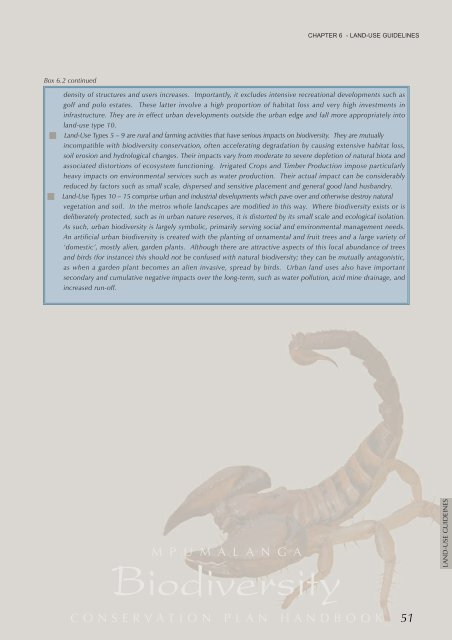Mpumalanga Biodiversity Conservation Plan Handbook - bgis-sanbi
Mpumalanga Biodiversity Conservation Plan Handbook - bgis-sanbi
Mpumalanga Biodiversity Conservation Plan Handbook - bgis-sanbi
Create successful ePaper yourself
Turn your PDF publications into a flip-book with our unique Google optimized e-Paper software.
Box 6.2 continued<br />
M P U M A L A N G A<br />
<strong>Biodiversity</strong><br />
CHAPTER 6 - LAND-USE GUIDELINES<br />
density of structures and users increases. Importantly, it excludes intensive recreational developments such as<br />
golf and polo estates. These latter involve a high proportion of habitat loss and very high investments in<br />
infrastructure. They are in effect urban developments outside the urban edge and fall more appropriately into<br />
land-use type 10.<br />
Land-Use Types 5 – 9 are rural and farming activities that have serious impacts on biodiversity. They are mutually<br />
incompatible with biodiversity conservation, often accelerating degradation by causing extensive habitat loss,<br />
soil erosion and hydrological changes. Their impacts vary from moderate to severe depletion of natural biota and<br />
associated distortions of ecosystem functioning. Irrigated Crops and Timber Production impose particularly<br />
heavy impacts on environmental services such as water production. Their actual impact can be considerably<br />
reduced by factors such as small scale, dispersed and sensitive placement and general good land husbandry.<br />
Land-Use Types 10 – 15 comprise urban and industrial developments which pave over and otherwise destroy natural<br />
vegetation and soil. In the metros whole landscapes are modified in this way. Where biodiversity exists or is<br />
deliberately protected, such as in urban nature reserves, it is distorted by its small scale and ecological isolation.<br />
As such, urban biodiversity is largely symbolic, primarily serving social and environmental management needs.<br />
An artificial urban biodiversity is created with the planting of ornamental and fruit trees and a large variety of<br />
‘domestic’, mostly alien, garden plants. Although there are attractive aspects of this local abundance of trees<br />
and birds (for instance) this should not be confused with natural biodiversity; they can be mutually antagonistic,<br />
as when a garden plant becomes an alien invasive, spread by birds. Urban land uses also have important<br />
secondary and cumulative negative impacts over the long-term, such as water pollution, acid mine drainage, and<br />
increased run-off.<br />
CONSERVATION PLAN HANDBOOK<br />
51<br />
LAND-USE GUIDEINES

















